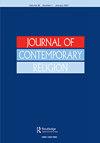Salafism and the State: Islamic Activism and National Identity in Contemporary Indonesia
IF 0.6
3区 哲学
0 RELIGION
引用次数: 1
Abstract
space of boundless freedom and unbridled opportunity. After an initial period marked by suspicion, notes Gary R. Bunt, established authorities and institutions changed course and began engaging in internet-based activities, often by embedding themselves in existing web sites. This trend is not limited to Sunni Islam. In his contribution, Babak Rahimi documents the internet presence of Shia clerics, many of whom, following the lead of the Grand Ayatollah Ali Sistani, have established their own web sites and Instagram accounts. Such gatekeepers raise barriers that restrict the agency of new entrants. Neither should cyberspace be considered independently from physical space. In his study of Habib Luthfi Bin Yahya, Ismail Fajrie Alatas shows how the Indonesian Sufi shaykh uses his web site to attract new participants to the monthly gatherings held at his congregational centre where his disciples fulfil the requirement of ‘companionship’ (suh ba) with their master. Other contributions, such as Andrea Stanton’s study of pilgrimage apps and Rosemary Pennington’s survey of Eid alAdha videos on Instagram, suppose a relationship between the digital and analogue worlds. Although the authors register the popularity of these media, they make no attempt to link digital use to behaviour in real life (IRL). How many Cyber Muslims will make the journey to Mecca or attend a celebration at their local mosque? The question is of empirical and theoretical importance, for, if Durkheim is right that religion is always a collective phenomenon, we can expect communal ritual practice to increase with the use of Islamic digital media—a trend that, if confirmed, would belie more widely received notions which associate internet use and social isolation. The web sites, apps, and social media accounts detailed in this volume represent a small fraction of Islamic cyberspace. Wisely, Rozehnal makes no claims to exhaustivity. Rather, he and his contributors have produced an original work that opens up new lines of inquiry in an ever-expanding field.萨拉菲主义与国家:当代印尼的伊斯兰激进主义与民族认同
无限自由和无限机遇的空间。Gary R.Bunt指出,在经历了一段充满怀疑的最初时期后,权威机构和机构改变了方向,开始从事基于互联网的活动,通常是通过嵌入现有网站。这种趋势不仅限于逊尼派伊斯兰教。巴巴克·拉希米在他的贡献中记录了什叶派神职人员在互联网上的存在,其中许多人在大阿亚图拉·阿里·西斯塔尼的领导下,建立了自己的网站和Instagram账户。这样的看门人增加了限制新进入者代理的障碍。网络空间也不应独立于物理空间来考虑。伊斯梅尔·法杰里·阿拉塔斯(Ismail Fajrie Alatas)在对哈比卜·卢特菲·本·叶海亚(Habib Luthfi Bin Yahya ba)与他们的主人。其他贡献,如Andrea Stanton对朝圣应用程序的研究,以及Rosemary Pennington对Instagram上宰牲节视频的调查,都假设了数字世界和模拟世界之间的关系。尽管作者记录了这些媒体的受欢迎程度,但他们没有试图将数字使用与现实生活中的行为联系起来(IRL)。有多少网络穆斯林会前往麦加或参加当地清真寺的庆祝活动?这个问题具有经验和理论上的重要性,因为如果涂尔干认为宗教始终是一种集体现象是正确的,我们可以预期,随着伊斯兰数字媒体的使用,公共仪式实践会增加——如果得到证实,这一趋势将掩盖更广泛接受的将互联网使用和社会孤立联系在一起的观念。本卷中详细介绍的网站、应用程序和社交媒体账户只代表伊斯兰网络空间的一小部分。明智的是,Rozehnal没有声称自己是穷尽性的。相反,他和他的撰稿人创作了一部原创作品,在一个不断扩大的领域开辟了新的研究方向。
本文章由计算机程序翻译,如有差异,请以英文原文为准。
求助全文
约1分钟内获得全文
求助全文
来源期刊

Journal of Contemporary Religion
RELIGION-
CiteScore
1.20
自引率
0.00%
发文量
59
期刊介绍:
Journal of Contemporary Religion is an international peer reviewed journal. Its purpose is to both document and evaluate the anthropological, sociological, psychological, and philosophical aspects of emerging manifestations of religiosity in any part of the world—whether within innovative movements or mainstream institutions. The term ''religion'' in the title of this journal is understood to include contributions on spirituality. Moreover, as the journal title suggests, the focus is on contemporary issues. Therefore, the editors of Journal of Contemporary Religion welcome submissions which deal with: classical topics in the study of religion, such as secularisation and the vitality of religion or traditional sectarian movements; more recent developments in the study of religion, including religion and social problems, religion and the environment, religion and education, the transmission of religion, the materialisation and visualisation of religion in various forms, new forms of religious pluralism, the rise of new forms of religion and spirituality, religion and the Internet, religion and science, religion and globalisation, religion and the economy, etc. theoretical approaches to the study of religion; discussions of methods in relation to empirical research; qualitative and quantitative research and related issues. The Journal includes reviews of books which reflect the above themes.
 求助内容:
求助内容: 应助结果提醒方式:
应助结果提醒方式:


